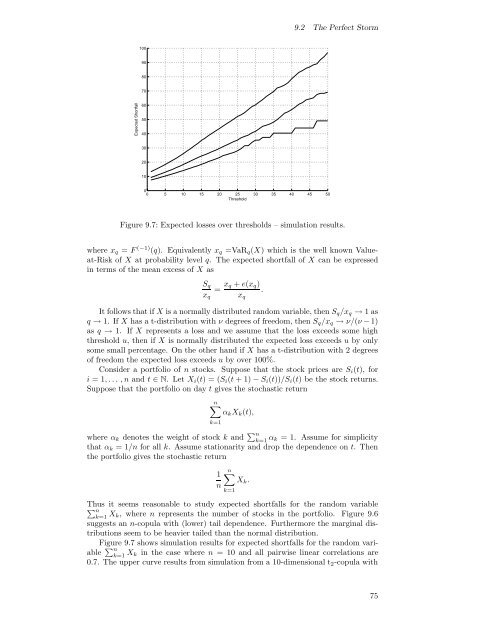Modelling Dependence with Copulas - IFOR
Modelling Dependence with Copulas - IFOR
Modelling Dependence with Copulas - IFOR
You also want an ePaper? Increase the reach of your titles
YUMPU automatically turns print PDFs into web optimized ePapers that Google loves.
9.2 The Perfect Storm<br />
100<br />
90<br />
80<br />
70<br />
Expected Shortfall<br />
60<br />
50<br />
40<br />
30<br />
20<br />
10<br />
0<br />
0 5 10 15 20 25 30 35 40 45 50<br />
Threshold<br />
Figure 9.7: Expected losses over thresholds – simulation results.<br />
where x q = F (−1) (q). Equivalently x q =VaR q (X) which is the well known Valueat-Risk<br />
of X at probability level q. The expected shortfall of X can be expressed<br />
in terms of the mean excess of X as<br />
S q<br />
= x q + e(x q )<br />
.<br />
x q x q<br />
It follows that if X is a normally distributed random variable, then S q /x q → 1as<br />
q → 1. If X has a t-distribution <strong>with</strong> ν degrees of freedom, then S q /x q → ν/(ν − 1)<br />
as q → 1. If X represents a loss and we assume that the loss exceeds some high<br />
threshold u, thenifX is normally distributed the expected loss exceeds u by only<br />
some small percentage. On the other hand if X has a t-distribution <strong>with</strong> 2 degrees<br />
of freedom the expected loss exceeds u by over 100%.<br />
Consider a portfolio of n stocks. Suppose that the stock prices are S i (t), for<br />
i =1,... ,n and t ∈ N. Let X i (t) =(S i (t +1)− S i (t))/S i (t) be the stock returns.<br />
Suppose that the portfolio on day t gives the stochastic return<br />
n∑<br />
α k X k (t),<br />
k=1<br />
where α k denotes the weight of stock k and ∑ n<br />
k=1 α k = 1. Assume for simplicity<br />
that α k =1/n for all k. Assume stationarity and drop the dependence on t. Then<br />
the portfolio gives the stochastic return<br />
1<br />
n<br />
n∑<br />
X k .<br />
k=1<br />
Thus<br />
∑<br />
it seems reasonable to study expected shortfalls for the random variable<br />
n<br />
k=1 X k,wheren represents the number of stocks in the portfolio. Figure 9.6<br />
suggests an n-copula <strong>with</strong> (lower) tail dependence. Furthermore the marginal distributions<br />
seem to be heavier tailed than the normal distribution.<br />
Figure 9.7 shows simulation results for expected shortfalls for the random variable<br />
∑ n<br />
k=1 X k in the case where n = 10 and all pairwise linear correlations are<br />
0.7. The upper curve results from simulation from a 10-dimensional t 2 -copula <strong>with</strong><br />
75
















